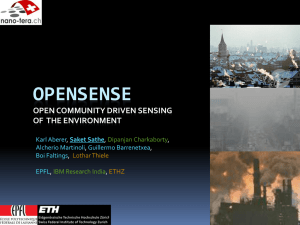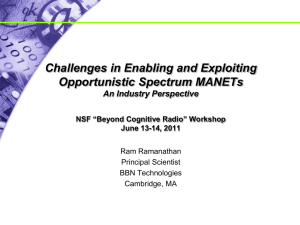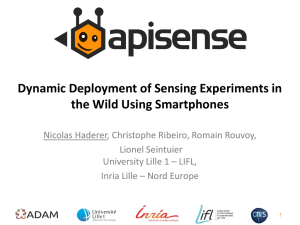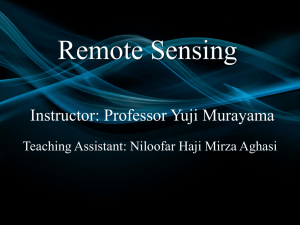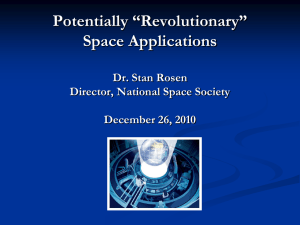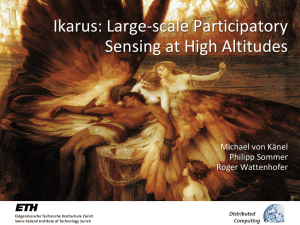lecture-1 Introduction - Centre of Studies In Resources
advertisement
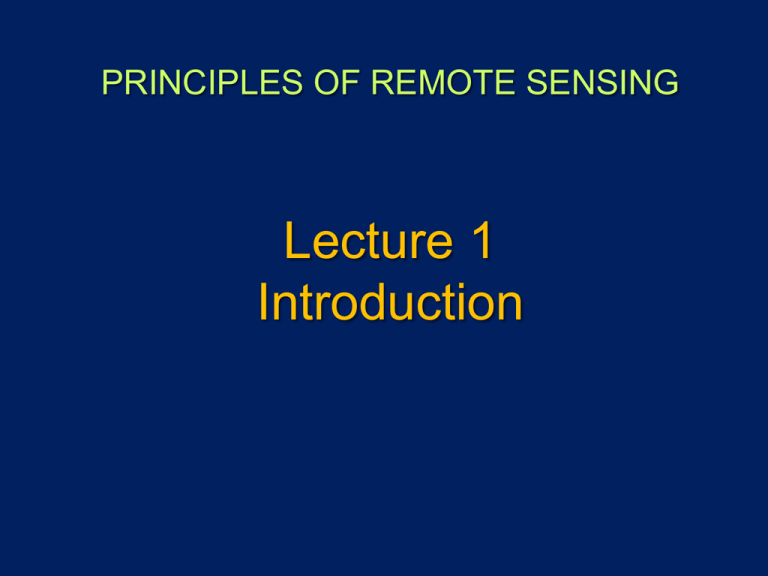
PRINCIPLES OF REMOTE SENSING Lecture 1 Introduction GROUND RULES Assessments and Examinations: • Total marks: 100 (AP - 85; YSR – 15) • Distribution of my 85 marks: • • Mid-semester examination – 25 • End-semester examination – 35 • Assignments – 10 • Quizzes (3 + 1 unannounced) – 10 • Seminar - 5 Assignments and quiz would be distributed through out the semester. GROUND RULES Attendance: • Attendance would be taken; 85% attendance COMPULSARY NO COMPROMISE ON PUNCTUALITY ………….. GROUND RULES GROUND RULES Lecture notes / Working folder http://www.csre.iitb.ac.in/~alok/GNR603_2014/ COURSE OBJECTIVES To understand: - the physics, chemistry, and technology involved in remote sensing - the techniques for preprocessing aerospace remote sensing images (processing techniques will be covered in SIP course) - panchromatic, multispectral and hyperspectral remote sensing in different parts of the electromagnetic spectrum and to learn how to interpret the images acquired using these sensors In short, the primary objective is to provide the conceptual foundations and technical skills to apply remote sensing to solve real-world problems. COURSE CONTENTS • History and development of remote sensing • Electromagnetic radiation - nature and sources, interaction with matter and atmosphere • Atmospheric windows and effects, corrections ----------------- I Quiz • Multispectral systems • Characteristics of important remote sensing systems: LANDSAT, IRS, ASTER, SPOT; High resolution sensors • Hyperspectral systems • Thermal systems ------------------- II Quiz • Microwave systems • Interpretations and applications - agriculture, forestry, land-use mapping, geology, water resources etc etc. … and Arial Photography/Photogrammetry. ------------------- III Quiz A remote sensing image (Band 1 – B) A remote sensing image (Band 2 – G) A remote sensing image (Band 3 – R) A remote sensing image (Band 4 – VNIR) A remote sensing image (Band 6 – TIR) A remote sensing image (TCC) A remote sensing image (FCC 247) A remote sensing image (FCC 234) Remote sensing : Perspective • Concept: what do we understand by remote sensing? • Importance: • Is it just pretty pictures or serious science? • Does it add to our understanding of natural systems and resources? • Applications to natural resources studies Remote sensing : Concept Acquisition of information about an object without making physical contact Earth: surface, atmosphere, hydrosphere, cryosphere planets sun stars; galaxies etc Remote sensing : Concept Most widely used remote sensors: human eyes • Motivation for remote sensing systems • Collection (eye), transmission (optic nerve) and storage (brain) • Cannot distribute the data though Remote Sensing : Concept • The sensor collects information within its IFOV (resolution cell) without being in direct physical contact with it. • The sensor can be located on ground, aircraft and spacecraft platforms. Remote sensing : Concept Technology, science and art of obtaining information about an object, area, or phenomenon through the analysis of data acquired by a device that is not in contact with the object, area or phenomenon under the investigation. Technology : data collection Science and technology : data processing and analysis Science and art : data interpretation Remote sensing : Concept ASPRS formal definition of photogrammetry and remote sensing: “the art, science, and technology of obtaining reliable information about physical objects and the environment, through the process of recording, measuring and interpreting imagery and digital representations of energy patterns derived from non-contact sensor systems.” A Systems View of Remote Sensing Remote Sensing Passive Reflected light Aerial photography Visible/near IR/SWIR imaging Thermal emission Thermal imaging Active Passive Microwave Passive microwave radiometry Microwave sounding Visible/IR Laser Profiling and Lidar Active Microwave Altimetry, Scatterometry Synthetic Aperture Radar Remote Sensing Process Science goal Data Acquisition 1) In situ measurements (GPS, bio-mass, soil moisture, spectroradiometer, etc.) 2) Remote Sensing Data (passive and active remote sensing ) Data processing and analysis Information extraction Visual interpretation Digital Image Processing Scientific Visualization Types and classes of remote sensing data Spatial Information Imagers Altimeters Sounders Spectral Spectrometers Information (Polarimeters) Scatterometers Radiometers Intensity Information Other types of remote sensing Geophysical Sonar Advantages of Remote Sensing • Data can be gathered from large areas of the Earth’s surface or atmosphere in short space of time. • In situ measurements are time consuming and costly over large areas. Remote Sensing is considered as cost effective. • No sampling bias - consistent coverage of the entire area • Response of objects collected in different wavelengths Limitations of Remote Sensing • Often oversold • Provides information only about the spectral properties of objects on the earth’s surface (and their variation in time and space). We hope that the spectral properties are proxies for the property we are interested in. • Noise – atmospheric effects, topographic effects, soil/vegetation cover • Often considered an end in it self (the pretty picture syndrome!) - remote sensing should enhance scientific understanding of the system under study. Applications of Remote Sensing Atmosphere Lithosphere Hydrosphere Cryosphere Planetary science Land cover and land use Military . Further Reading Books : • Remote Sensing and Image Interpretation, Lillesand, Kiefer, Chipman, 2007 • Introduction to Remote Sensing, Campbell, 1996 • Remote Sensing : Principles and interpretation, Sabins, 1997 • Physical Principles of Remote Sensing, Rees, 2001 • Introduction to physics and techniques of remote sensing, Elachi, 1987 • Remote Sensing of the Environment : An earth resource perspective, Jensen , 2000 Journals : • Remote Sensing of Environment • International Journal of Remote Sensing • IEEE Trans. Geoscience and Remote Sensing • Photogrammetric Engineering and Remote Sensing • ISPRS • ISPRS Photogrammetry and Remote Sensing


